We get to go to Heald Island again. Yippee! That means another ride in the helicopter. Yesterday I was running around trying not to miss my flight. I was so excited about everything that I didn't really get a chance to properly tell you about the helicopter. This is a picture of the helicopter that I am riding in today.
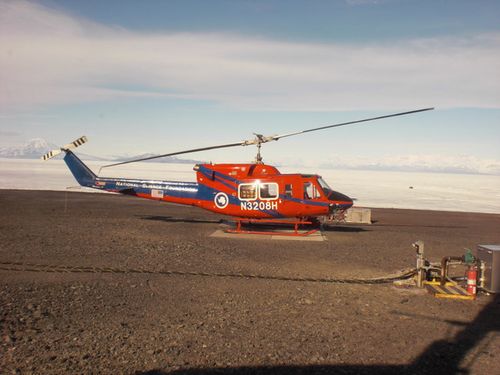 This is one of the helicopters owned by the National Science Foundation.
This is one of the helicopters owned by the National Science Foundation.
It can carry 8 passengers, 2 pilots, and a bunch of luggage. There are several things that you have to do to insure that you have a fun and safe trip. The first things you have to do are to weigh and tag all of the equipment. Then you grab a helmet with a bag, your ECW bag, and get weighed. You only approach the helicopter when you are told to. You climb into the helicopter and fasten your seatbelt. It is a bit more complicated than the seatbelt in a car. Next, you put on your helmet and hook it up to a control that allows you to hear the pilot and the other passengers. There are several signs that give you instructions. This sign reminds you not to open the door but rather let the pilot or helo tech do it. It also shows the emergency window that you can just push out in an emergency.
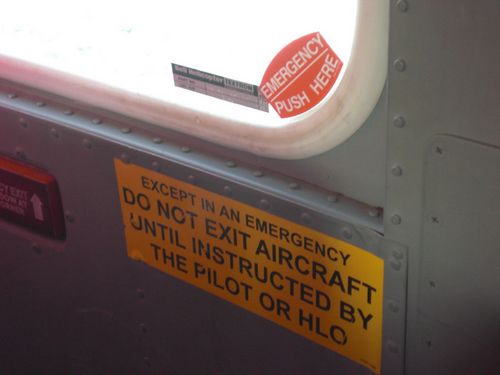 There are emergency windows and two small fire extinguishers on the helicopter. I hope I don't need to use them.
There are emergency windows and two small fire extinguishers on the helicopter. I hope I don't need to use them.
This sign reminds you not to approach the tail rotor. When you exit the helicopter it is a bit disorienting and you really have to pay attention to the directions the pilot is giving you.
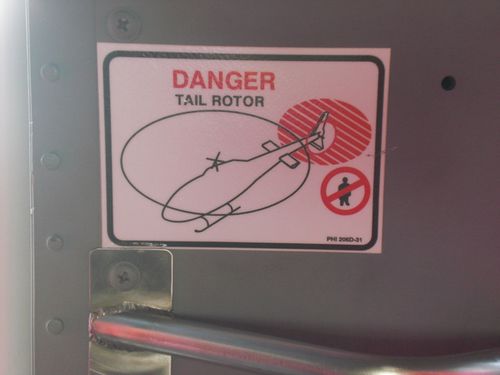 Always walk away from the blades on the helicopter. The pilot will point the direction for you.
Always walk away from the blades on the helicopter. The pilot will point the direction for you.
The last sign looks very much like the one you see on an airplane. I don't know if it lights up or not, but you can never undo your seatbelt or smoke.
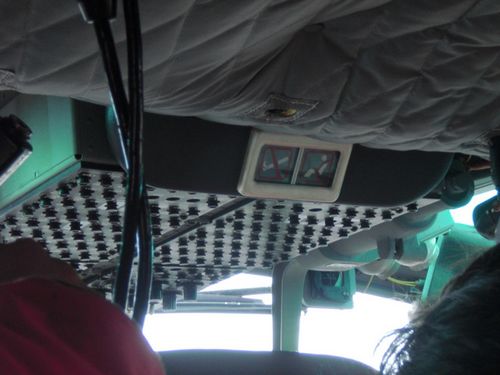 You almost think that you are on an airplane until you look out and there are no wings.
You almost think that you are on an airplane until you look out and there are no wings.
The ride was just as exciting as the one yesterday. The view is incredible. I think it looks like someone spilled milk on a light blue table.
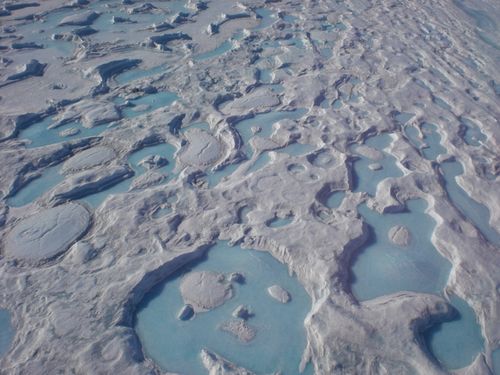 The window in the helicopter allows you to have a glimpse of the massive sea ice.
The window in the helicopter allows you to have a glimpse of the massive sea ice.
Once we landed it was time to get to work. Stacy and I were responsible for drilling some holes. The first hole was a bit difficult. The ice was harder than any I had drilled through before. However, girl power prevailed and we broke through to the water. The next hole was without a doubt the hardest one I have done so far. At one point Stacy literally lifted her feet and swung around. Unfortunately, Stacy also wretched her back out, but she kept working until the end. Scott saw how much we were struggling and came to help. Even with three of us, it was still a struggle. Now I am going to share a short video that Stacy took of me and Scott. Try not to laugh too hard.
http://
We were on the sixth flight (remember each flight is a meter or about 3 feet long) and as we approached the ground we suddenly broke through the ice. However, we had no sooner congratulated ourselves than we were stuck in the ice. Stacy thought that the water was so cold that it immediately froze the snow that had fallen in the hole. We twisted and pulled and finagled until we had recovered three flights. Each flight costs about $300 and we didn't want to lose the money or leave a foreign object in the ice. We decided to go ahead and launch SCINI and then work on freeing the last three flights. Unfortunately, we were only able to free one additional flight. We will try again on another day.
After the launch Stacy and I took a few minutes to check on the flags.
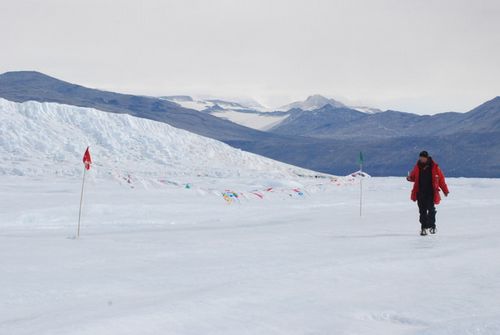 The flags are strung up to guage the effects of the katabatic winds.
The flags are strung up to guage the effects of the katabatic winds.
These flags were made by the students of one of Stacy's friends. They made a flag for each country that signed the Antarctic Treaty. They are so beautiful that it is almost a shame to hang them up in this wind. However, the students are interested in seeing the effects of the katabatic winds. As you may remember, these are winds that carry high density air from a higher elevation down a slope under the force of gravity. They are sometimes referred to as "fall winds" and have been known to reach hurricane speeds. They carry a prayer for each country and really are amazing.
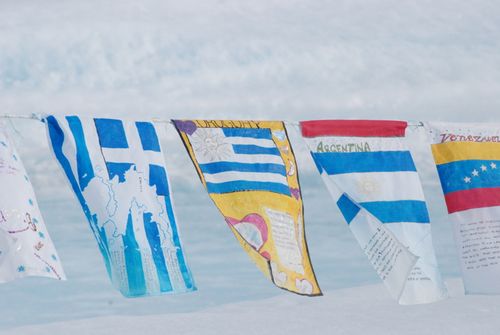 The prayer flags are each unique and beautiful.
The prayer flags are each unique and beautiful.
After SCINI finished her trip it was time to clean up. Everything has to be put away and secured.
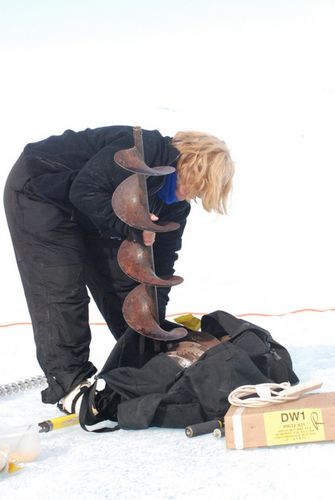 Everything must be put away and secured or you might lose it.
Everything must be put away and secured or you might lose it.
The winds picked up this afternoon and made us aware of just why securing everything is essential. However, even when we are working in ice-cold winds we try to have a good time. Francois decided to use himself to help coil and carry the many cables that we use to launch SCINI. He looks quite good in all of his bling.
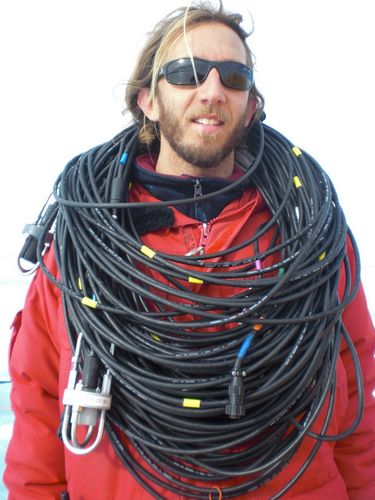 Francois wears the cables from the navigation system.
Francois wears the cables from the navigation system.
The helicopter was about 30 minutes early today and we were quite grateful. The pilot decided to show us a huge crack in the sea ice. It would be very interesting to check on it every few days. As the temperatures increase, will the crack open and if so how much?
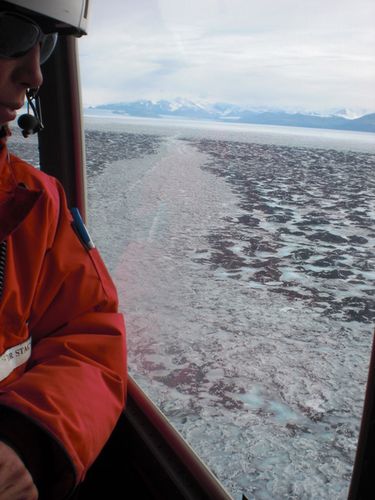 Stacy is looking out of the window of the helicopter to view the large crack in the sea ice.
Stacy is looking out of the window of the helicopter to view the large crack in the sea ice.
We actually made it back in time to go to the galley and get our own dinner. Afterwards I attended the weekly science lecture. It was about methane- and sulfur-producing microorganisms. It was very interesting. I am enjoying the opportunity to learn about so many different areas of science. McMurdo Station is a smorgasbord of cutting-edge science and I get to take a little taste every day. Lucky me!
I want to leave you with some images that SCINI took today. In an area that Stacy thought would have very little life, there was an extensive variety. Why do you think there is so much life when there is ice that is over 15 feet thick on the surface?
These are just some of the interesting things that we saw today. The first is an Antarctic cod which is a fish that is famous for producing antifreeze glycoprotein that allows it to survive the icy waters around Antarctica. It also is the object of cardiac research because its heart beat once every 6 seconds. Try to determine its size. The red laser points are 12 centimeters apart which should help you determine the size of the head.
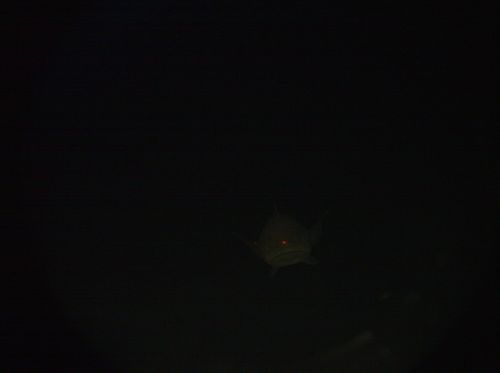 This fish is also known as the Antarctic toothfish.
This fish is also known as the Antarctic toothfish.
Another image that I thought was interesting was the Sea pansy. It is a type of octacoral due to the fact that its arms appear in groups of eight.
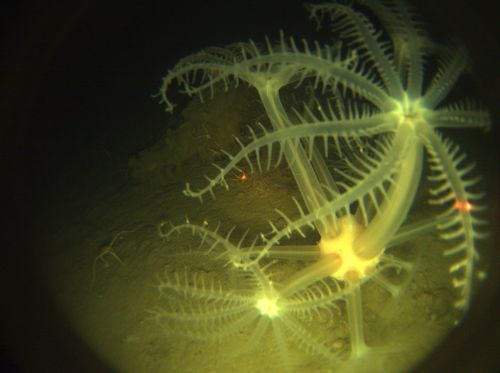 Each pansy has eight arms.
Each pansy has eight arms.
Enjoy.
Today's Polar Profile is missing. We have been gone quite a bit lately. I will try to resume posting the videos as soon as possible. I really enjoy making them and getting a chance to meet some of these amazing people.

